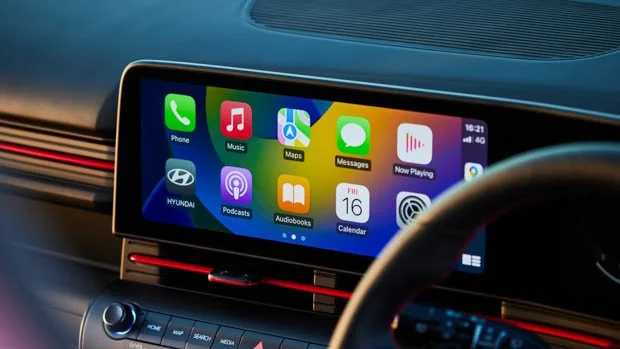What Is Wireless Apple CarPlay?
Wireless Apple CarPlay is a modern technology that allows drivers to connect their iPhone to their car’s infotainment system without the need for a USB cable. This system mirrors essential iPhone functions onto the car’s display, making it possible to use apps like navigation, messaging, music, and calls hands-free. Since its introduction, Apple CarPlay has transformed the driving experience, and the wireless version takes convenience to an even higher level.
Why Wireless CarPlay Is a Game-Changer
Traditionally, CarPlay required plugging the iPhone into the car using a cable. While effective, it was sometimes inconvenient, especially for drivers who preferred a clean, wire-free setup. With wireless CarPlay, all the benefits of the system are available instantly when you enter your vehicle. As long as your iPhone is within Bluetooth and Wi-Fi range, it connects automatically, eliminating clutter and making the experience smoother.
Key Features of Wireless Apple CarPlay
Wireless CarPlay offers a wide range of features that enhance both convenience and safety. Some of the most notable include:
- Navigation with Apple Maps, Google Maps, or Waze directly on your car’s display
- Hands-free messaging and calls using Siri voice commands
- Music and podcast streaming through Apple Music, Spotify, and other apps
- Calendar integration for reminders and schedules
- Third-party app support for services like WhatsApp and Audible
- Automatic connection when you enter the car, without needing to plug in your phone
These features allow drivers to stay connected without being distracted by their devices.
Benefits of Wireless CarPlay for Drivers
The advantages of switching to wireless CarPlay go beyond eliminating cables. The benefits include:
- Cleaner car interiors without dangling wires
- Instant connection without plugging in each time
- Enhanced safety with voice controls and larger on-screen buttons
- Multi-device compatibility for drivers who share a car
- Future-proof technology as more cars integrate wireless systems
For many drivers, the simplicity and safety improvements alone make wireless CarPlay worth the upgrade.
How Wireless Apple CarPlay Works
Wireless CarPlay relies on a combination of Bluetooth and Wi-Fi Direct technology. When you start your car, your iPhone first connects via Bluetooth for quick pairing. Then, Wi-Fi Direct takes over to handle the heavy data required for apps, maps, and music. This dual system ensures smooth and reliable performance without lag or interruptions.
Cars That Support Wireless CarPlay
Not all vehicles currently support wireless CarPlay, but the number is growing rapidly. Many new models from brands like BMW, Audi, Mercedes-Benz, Honda, Toyota, and Ford offer it as standard or optional. Luxury cars were the first to adopt the technology, but it’s now becoming common even in mid-range and entry-level vehicles. If you are buying a new car, checking for wireless CarPlay compatibility should be part of your decision-making process.
Upgrading Older Cars to Wireless CarPlay
For drivers whose vehicles don’t support wireless CarPlay, there are upgrade options available. Aftermarket wireless CarPlay adapters can be plugged into the car’s USB port, converting wired CarPlay systems into wireless ones. Additionally, aftermarket infotainment systems from brands like Pioneer and Alpine often include wireless CarPlay. This means that even older vehicles can enjoy the convenience of this modern technology without needing to purchase a new car.
Common Issues with Wireless CarPlay
While wireless CarPlay is highly convenient, it isn’t perfect. Some common issues include:
- Battery drain on the iPhone due to constant Wi-Fi usage
- Slight delays in audio or navigation when using third-party adapters
- Connection drops if the Wi-Fi signal is interrupted
- Limited availability in older vehicles without upgrade options
Most of these issues are minor and can be managed by keeping your iPhone updated, ensuring strong Wi-Fi signals, and using quality adapters.
Comparing Wireless vs. Wired CarPlay
The main difference between wired and wireless CarPlay is convenience. Wired connections may be slightly more stable, especially for long road trips, since they charge the phone while in use. Wireless CarPlay, on the other hand, prioritizes freedom and ease of use. Drivers who take short trips or prefer a tidy dashboard often favor the wireless version. Many drivers choose to keep both options available—using wireless for quick commutes and wired for longer journeys where charging is essential.
Safety Advantages of Wireless Apple CarPlay
One of the biggest advantages of CarPlay is safety. By enabling hands-free access to essential apps, drivers can keep their focus on the road. Siri voice commands let users send texts, make calls, or set navigation without touching their phone. Large, easy-to-read icons reduce distraction compared to manually operating a phone. Wireless CarPlay takes this a step further by removing the need to fumble with cables, making it faster to connect and safer to use.
The Future of Wireless CarPlay
Apple continues to expand CarPlay’s capabilities, and the wireless version is just the beginning. At recent technology events, Apple previewed the next-generation CarPlay interface, which integrates more deeply with a car’s hardware, such as climate controls and dashboard displays. As more manufacturers embrace this integration, wireless CarPlay is expected to become the standard for nearly all vehicles in the future.
Cost of Wireless CarPlay Upgrades
For new cars, wireless CarPlay often comes included at no extra cost. However, upgrading an existing vehicle may range from $100 to $500 depending on whether you choose an adapter or a new infotainment system. While this might seem like an investment, many drivers find it worthwhile for the added convenience, safety, and modern experience.
Where to Learn More About Wireless CarPlay
If you are considering adding wireless CarPlay to your car, resources are available online to help guide you. Apple provides an official page about CarPlay on its site, and many automotive technology websites offer reviews and recommendations. For a detailed look at compatibility and installation options, you can check Apple’s CarPlay page. Independent reviews and user experiences can also be found on platforms like Car and Driver’s CarPlay coverage.
Conclusion: Should You Switch to Wireless CarPlay?
The shift toward wireless Apple CarPlay represents the future of in-car connectivity. It offers a seamless, cable-free experience that enhances safety, convenience, and enjoyment on the road. While it may have minor drawbacks like battery drain or occasional connection drops, the benefits far outweigh the negatives. Whether you are buying a new car or upgrading your current one, wireless CarPlay is a smart choice that brings your driving experience in line with modern technology.











